Street Youth Ministry Uses Art to Reframe Conversation on Homelessness
By Nataleah Small
Reporting Texas
A collection of purple, orange and green stones appeared in front of the Congregational Church of Austin in early October. The stones were decorated to resemble pumpkins, and some were painted with words of affirmation such as “love” and “pride.”
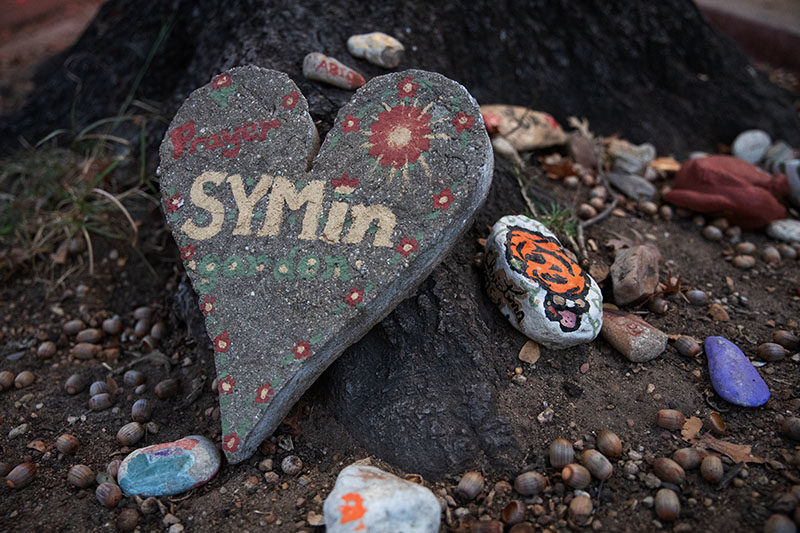
A prayer garden made of painted rocks marks the entrance to the Street Youth Ministry’s facility in the basement of the Congregational Church on 23rd Street in Austin, Texas. The rocks are a way for the ministry to draw attention to the positive impact of its mission. Joshua Guenther/Reporting Texas
Throughout November and December, more art popped up: a face and scarf on the tree in front of the church, colorful chalk art messages on the sidewalk and hearts and peace symbols stenciled on planter pots.
The group responsible for the guerilla art was Street Youth Ministry, which wanted to draw attention to the ministry and positively impact the thousands of people who pass the building every day, said Terry Cole, the ministry’s founder. He said the ministry began creating the installations after the Austin City Council lifted a camping ban and made other changes in the city’s approach to homelessness, which sparked contentious debate.

An art installation created by Street Youth Ministry clients showcases their desire to send a positive message to the community. Joshua Guenther/Reporting Texas
“We really just wanted to say to the neighborhood: ‘We love you, and we want to be kind to you as well,’” said Suzanne Zucca, Street Youth Ministry staff member.
Nestled in the heart of West Campus, Street Youth Ministry is located in the basement of the Congregational Church of Austin. The faith-based ministry is a day center that assists young people experiencing homelessness. Staffers refer to them as clients.
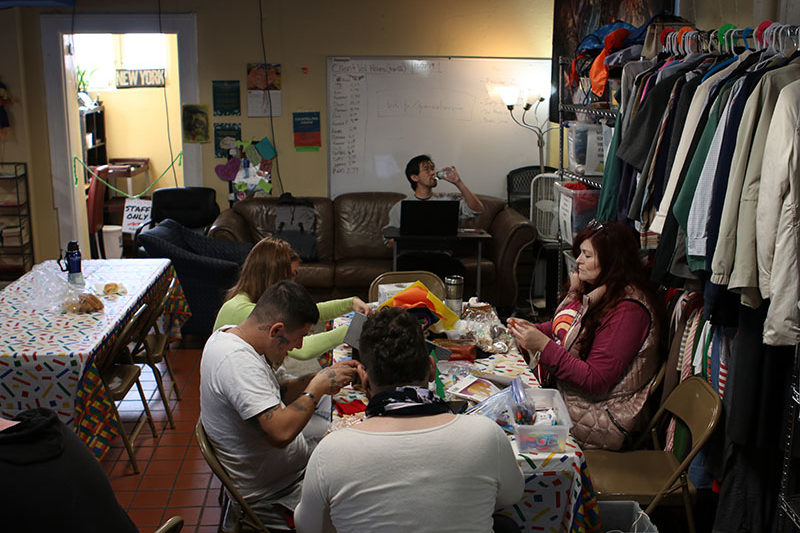
Volunteers of Street Youth Ministry set up arts and crafts for clients to make nativity scenes and angels. The program offers practical things like clothing, counseling and food, but its goal is “to know, love and serve street-dependent youth so they might come to know Christ,” according to its annual report. Alexander Thompson/Reporting Texas
According to its mission statement, the goal of the ministry is “to know, love and serve street-dependent youth so they might come to know Christ through the witnessing community we develop.” According to the ministry’s 2018 annual report, it provides clients with “practical things to help meet immediate needs.” Cole said the ministry is not an overnight facility.
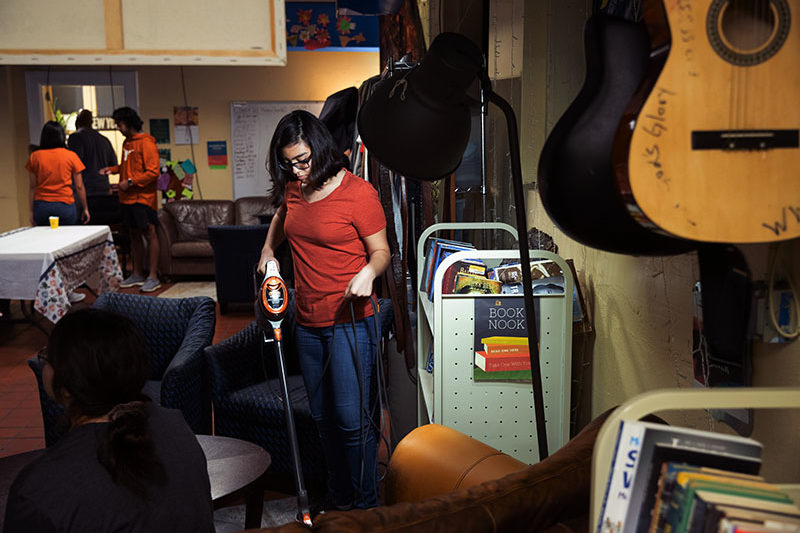
Volunteers, such as Lorena Garza, a UT-Austin social work freshman, play a crucial role in the ministry by cleaning and organizing the basement of the Congregational Church, where the program is housed. Joshua Guenther/Reporting Texas
The ministry offers a variety of services: access to food, counseling, clothing and gear such as bicycles and sleeping bags. Founded in 2008, the ministry serves about 600 clients up to 28 years old every year.
According GuideStar, a service that reports on U.S. non-profits, the ministry reported $492,267 in gross receipts during its most recent fiscal year. According to the ministry’s 2018 year-end report, 45% of its income is from private individuals and 30% is from in-kind giving. Additional funding comes from grants, churches and other sources. According to the report, 94% of every dollar spent by the ministry goes toward program services with the remaining 6% allotted to administration and fundraising.
Cole said the ministry employs eight staffers as guidance counselors and resources on matters related to drugs, physical and mental health and safe sex practices.
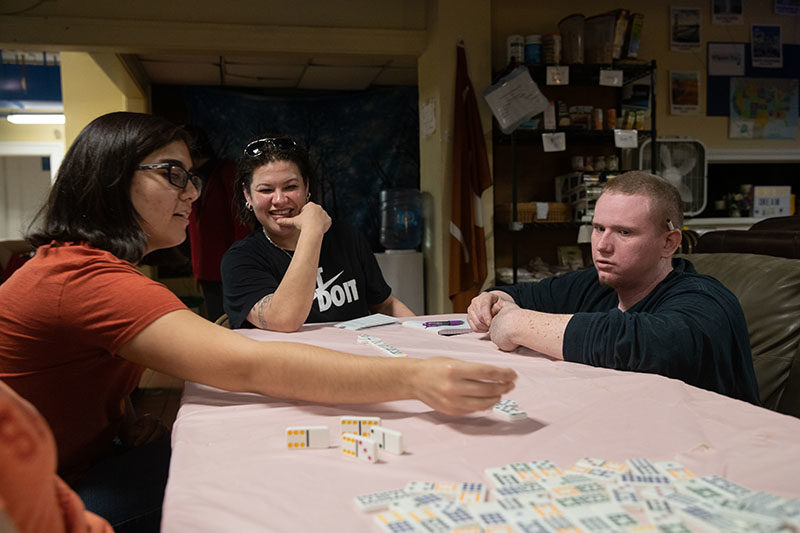
Street Youth Ministry volunteer Lorena Garza, left, plays dominoes with Deon Watts, right, and another client of the Street Youth Ministry during a weekly game night on Nov. 19, 2019. Joshua Guenther/Reporting Texas
The team is trained to handle difficult situations and deal with people in crisis, but Cole said team members are not doctors, social workers or licensed therapists. Nearly 1,000 individuals volunteer with the ministry every year, Cole said.
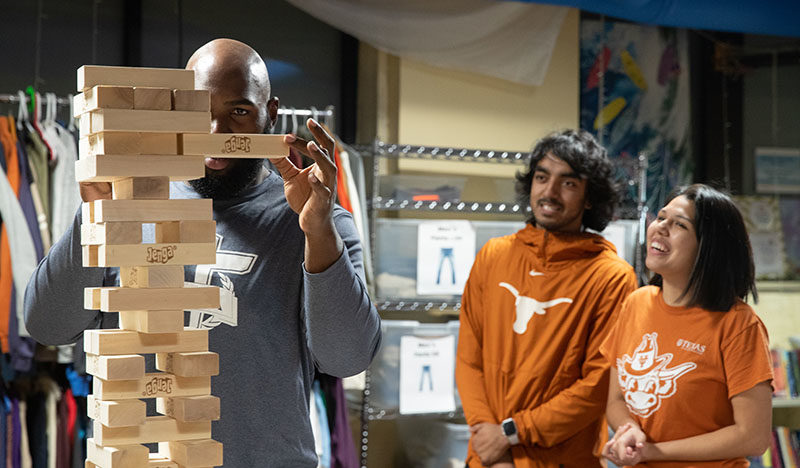
Patrick Hudson, left, removes a block from a giant Jenga set while volunteering at the Street Youth Ministry’s weekly game night with other UT-Austin students Shad Khan, center, and Nuvia Cruz. The ministry’s proximity to the University allows students to accumulate volunteer hours for class and service organizations. Joshua Guenther/Reporting Texas
Austin’s homeless population has remained relatively steady since the ministry began its work.
According to the Point In Time Count compiled annually by the Ending Community Homelessness Coalition, 2,087 people were counted in 2010. The lowest recorded number, 1,832, occurred in 2015. In 2019, the number of individuals increased to 2,255; 50% were between the ages of 18-44.
According to ECHO, the leading factors contributing to homelessness include inadequate access to health care, lack of engagement in school or employment and time spent in juvenile detention or jail.
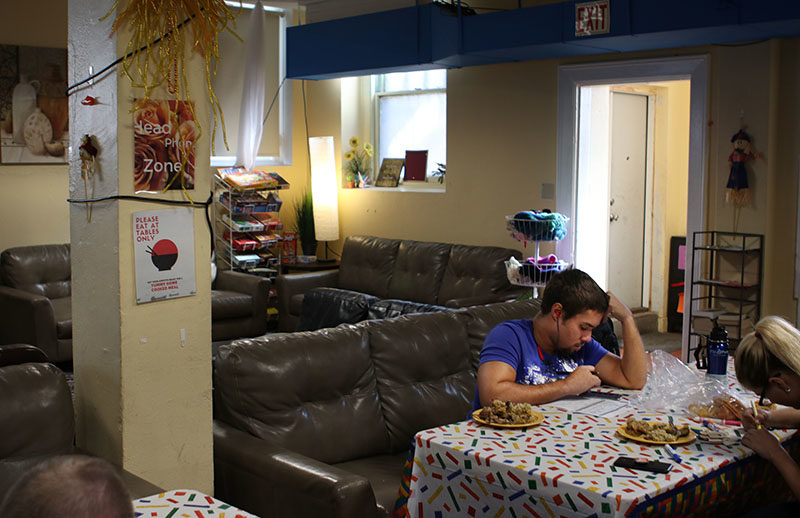
Two members visit the Street Youth Ministry basement to have a meal and fill out paperwork on Dec 3, 2019. The ministry opens everyday at 12 p.m. and provides a safe space for people 28 years old and younger. Alexander Thompson/Reporting Texas
In July, when the city passed an ordinance that decriminalized sitting, lying and camping in public places, people who had been sleeping in the woods and other unsafe areas started sleeping on the streets, Cole said. A population that had been hidden became more visible.
In reaction to the heightened visibility, Gov. Greg Abbott retweeted a video of a man attacking a car in downtown Austin. It was later revealed that the video was over a year old and the person recorded was not experiencing homelessness. Cole said the misleading post had a negative impact on public perception of homeless people and a “scarring” effect on the city.
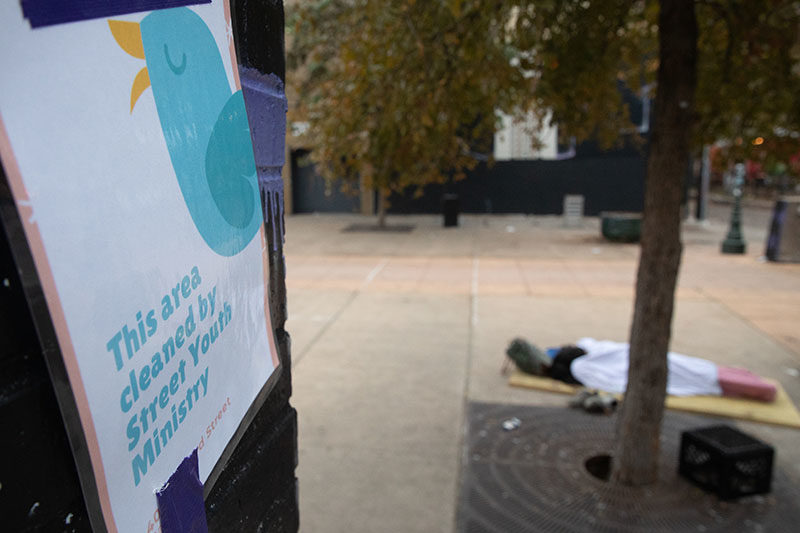
A sign posted at the 23rd street Artist’s Market notifies visitors that the Street Youth Ministry cleans the area. The ministry’s staff hope the message will counter some negative perceptions of people experiencing homelessness. Joshua Guenther/Reporting Texas
The idea for the art installation emerged amid this conversation. Cole said he wanted people walking by their building to notice a positive change and reflect on how the ministry is serving its clients.
Two clients who worked on the installation agreed to talk to Reporting Texas but declined to give their full names.
Red said she painted a rock that resembles a “golden ghost” the day she was taken to jail for having too many unpaid tickets. By the time she got out of jail, other clients had added the face to the tree in front of the building.
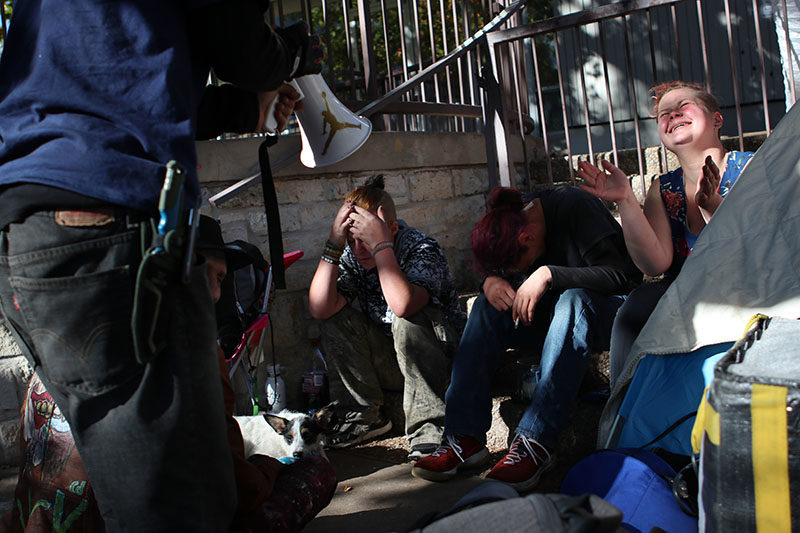
Red, who only wanted to be identified by her first name, laughs as her friend pulls out a bullhorn while they sit near the entrance of the Street Youth Ministry basement on Dec 3, 2019. Alexander Thompson/Reporting Texas
Red, 28, said she has traveled through Austin six times over the past decade. A friend introduced her to the ministry three years ago, and since then she has utilized its services.
She participates in Girl’s Group, a peer support group that discusses topics such as toxic relationships and the difficulties that face women who live on the streets. If she hadn’t heard about the ministry, Red said, she would have died in Austin because she knew few people and didn’t know where to stay.
“I feel like we have a family, and that’s rare around here,” Red said. “Like we have our street family, but you can’t talk to your street family about certain things, you know, you’ve got to stay within the mindset of ‘I can survive.’”
Arthur also helped create the installation. He created a collection of rocks painted with single words of prayer like “love,” “pride,” and “joy.”
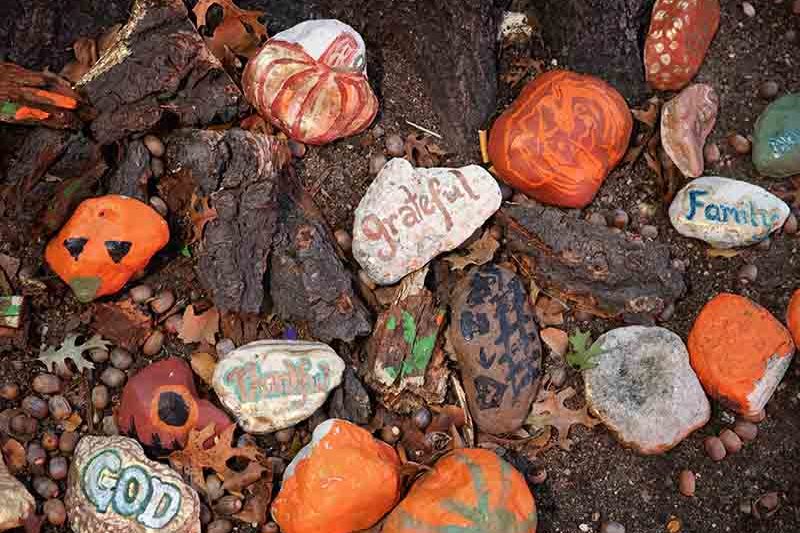
Halloween-themed prayer rocks that youth ministry client, Arthur, helped create, decorate the base of a tree outside the entrance to the Street Youth Ministry. Joshua Guenther/Reporting Texas
Arthur, 27, said he came to Austin four years ago with his former husband. When they divorced, he ended up on the streets. He said his “blood sister” told him Street Youth Ministry could help him, but he didn’t know if he would be accepted because of his sexual orientation. In other places he said he has felt out of place and unwelcome.
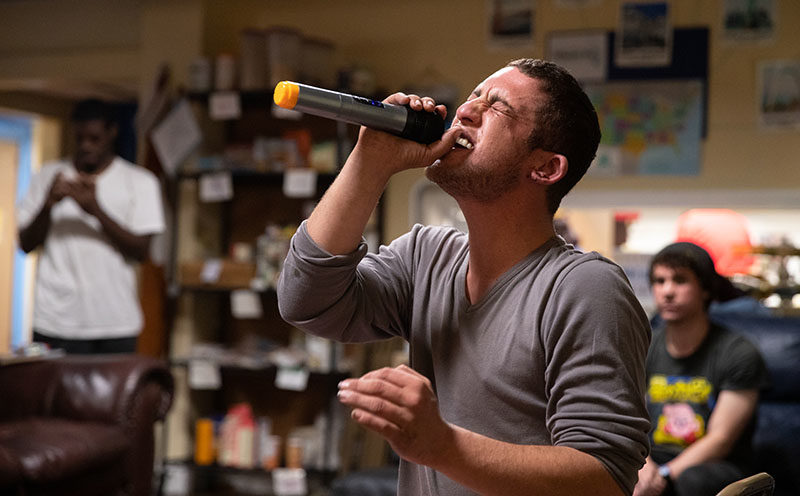
Street Youth Ministry client Arthur, whose nickname is Summer Rose, sings Carrie Underwood’s, “Jesus, Take The Wheel,” during the weekly talent night on Nov. 20, 2019. Arthur, said the ministry has come to feel like a family to him. Joshua Guenther/Reporting Texas
Earlier this year, he said he was diagnosed with stage four brain cancer. Since the diagnosis, members of the ministry have prayed for him, Arthur said, and in return he has volunteered to prepare food, wash dishes and clean the space.
“It feels like I’m back at home with my own family,” Arthur said. “There’s no other place I would rather be than here. I don’t want to separate from the people that have taken care of me.”